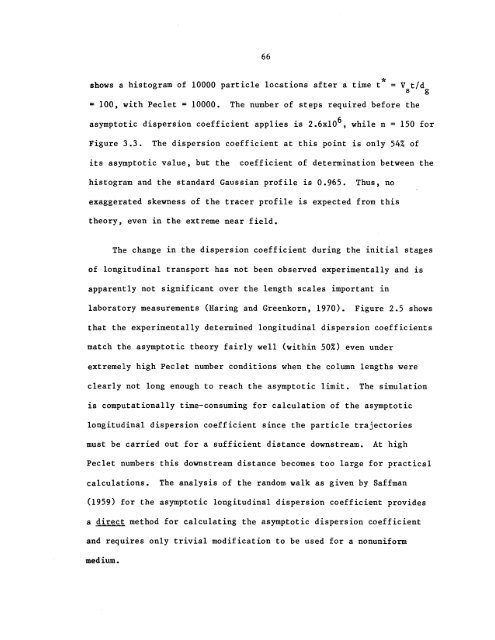longitudinal dispersion in nonuniform isotropic porous media
longitudinal dispersion in nonuniform isotropic porous media
longitudinal dispersion in nonuniform isotropic porous media
You also want an ePaper? Increase the reach of your titles
YUMPU automatically turns print PDFs into web optimized ePapers that Google loves.
shows a histogram of 10000 particle locations after a time t * = V tId<br />
s g<br />
= 100, with Peclet = 10000. The number of steps required before the<br />
66<br />
asymptotic <strong>dispersion</strong> coefficient applies is 2.6xl0 6 , while n = 150 for<br />
Figure 3.3. The <strong>dispersion</strong> coefficient at this po<strong>in</strong>t is only 54% of<br />
its asymptotic value, but the coefficient of determ<strong>in</strong>ation between the<br />
histogram and the standard Gaussian profile is 0.965. Thus, no<br />
exaggerated skewness of the tracer profile is expected from this<br />
theory, even <strong>in</strong> the extreme near field.<br />
The change 1n the <strong>dispersion</strong> coefficient dur<strong>in</strong>g the <strong>in</strong>itial stages<br />
of <strong>longitud<strong>in</strong>al</strong> transport has not been observed experimentally and is<br />
apparently not significant over the length scales important <strong>in</strong><br />
laboratory measurements (Har<strong>in</strong>g and Greenkorn, 1970). Figure 2.5 shows<br />
that the experimentally determ<strong>in</strong>ed <strong>longitud<strong>in</strong>al</strong> <strong>dispersion</strong> coefficients<br />
match the asymptotic theory fairly well (with<strong>in</strong> 50%) even under<br />
extremely high Peclet number conditions when the column lengths were<br />
clearly not long enough to reach the asymptotic limit. The simulation<br />
is computationally time-consum<strong>in</strong>g for calculation of the asymptotic<br />
<strong>longitud<strong>in</strong>al</strong> <strong>dispersion</strong> coefficient s<strong>in</strong>ce the particle trajectories<br />
must be carried out for a sufficient distance downstream. At high<br />
Peclet numbers this downstream distance becomes too large for practical<br />
calculations. The analysis of the random walk as given by Saffman<br />
(1959) for the asymptotic <strong>longitud<strong>in</strong>al</strong> <strong>dispersion</strong> coefficient provides<br />
a direct method for calculat<strong>in</strong>g the asymptotic <strong>dispersion</strong> coefficient<br />
and requires only trivial modification to be used for a <strong>nonuniform</strong><br />
medium.

















